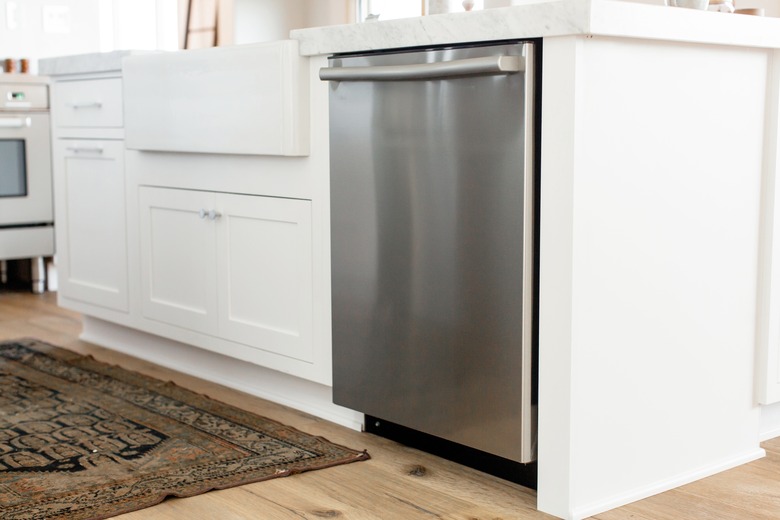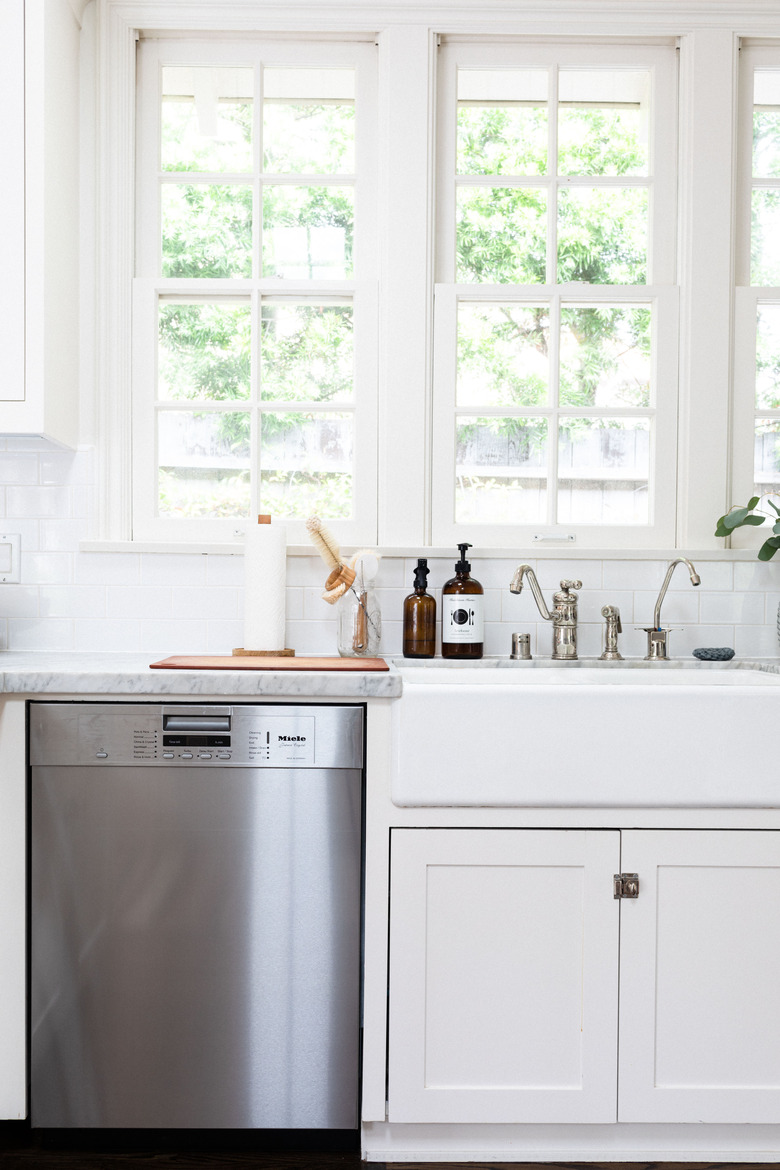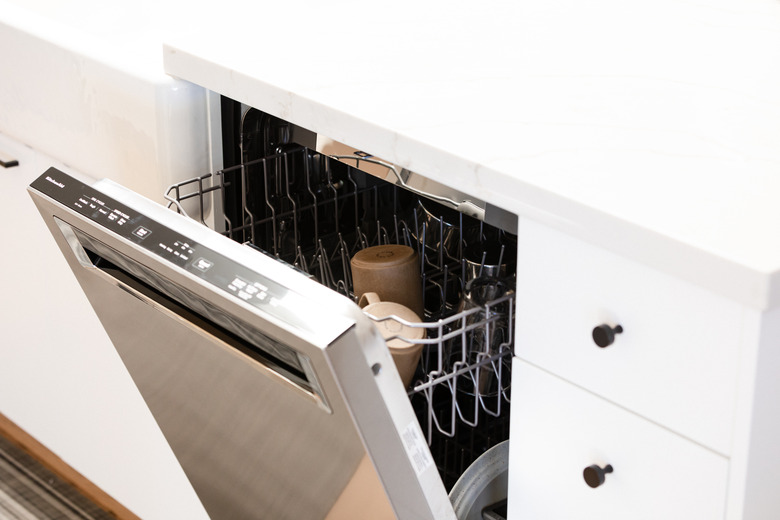How To Install A Dishwasher
We may receive a commission on purchases made from links.
Whether you're doing a dishwasher installation in your house for the first time or you're replacing an old dishwasher, you can do the job yourself, but you'll have to put on both your DIY plumber and electrician hats. You may even need to do some carpentry if you haven't already prepared an alcove for the appliance next to the kitchen sink. A standard dishwasher requires a space approximately 24-inches wide, 24-inches deep and 35-inches high, and you may have to carve out this space from the existing cabinets yourself using the actual dimensions of the dishwasher as your guide.
Assuming the alcove has already been created and that it isn't occupied by your old dishwasher, the tasks before you include:
- Hooking up the water supply
- Connecting the drain hose to the sink drain tailpiece or the garbage disposal
- Making the electrical connections
- Leveling the dishwasher, setting it in place and securing it to the countertop
Most of the parts you need should be supplied with the dishwasher, but you may need to purchase a flexible water hose with the proper connections for the dishwasher and the hot water shutoff valve. Most dishwashers come with a power cord, so you need to make sure there is a 120-volt, 15- or 20-amp outlet within reach of the cord when the dishwasher is installed. Alternatively, a dishwasher can also be hard-wired. This usually makes the most sense when you're replacing a similarly hard-wired dishwasher, and you can simply connect the existing electrical cable to the new unit.
Dishwasher Electrical Wiring Requirements
Dishwasher Electrical Wiring Requirements
The electrical code requires the outlet for a dishwasher installation to have AFCI and, if it's within 6 feet of the kitchen sink, GFCI protection. To be on the safe side, it's best to have an electrician install an AFCI/GFCI outlet wherever you put it. Alternatively, you can install an AFCI/GFCI breaker in the panel to control the dishwasher circuit. Code requires GFCI outlets to be accessible, so it's best to install the outlet on the reverse side of the cabinet frame so you can reach it easily when you open the door.
If you have a garbage disposal and both the dishwasher and the disposal will be connected with a cord and plug, it makes sense to plug them both into the same receptacle if allowed by local code. In that case, you need a 20-amp outlet capable of handling the current draw from both appliances at the same time.
What Is an Air Gap, and Do I Need One?
What Is an Air Gap, and Do I Need One?
The dishwasher drain hose attaches to the sink drain tailpiece or the garbage disposal, which raises the possibility of contaminated water siphoning into the dishwasher in the event of a drain backup. An air gap is a dome-shaped fitting mounted to the kitchen sink drainboard that provides a break in the drain line to prevent this. The dishwasher drain line connects to the inlet port, the sink drain connects to the outlet and between the ports is a small vent opening.
Besides being an unattractive addition to your kitchen décor, an air gap has a habit of spitting out water whenever the dishwasher is draining, so it's disliked by homeowners as well as plumbers. Many state and local plumbing authorities allow an alternative, which is to loop the dishwasher drain line as high as possible inside the sink cabinet before connecting it to the kitchen sink drain.
Because dishwasher manufacturers are increasingly providing anti-siphon mechanisms in their products, some plumbing authorities are relaxing air gap requirements, but others are strengthening them. The American Society of Home Inspectors reports that Minnesota added an air gap requirement to the state plumbing code in 2016, so it isn't safe to make assumptions. Be sure to check.
Things Needed
-
Double-port shutoff valve
-
Drain tailpiece with dishwasher port
-
Drain hose
-
Hose clamps
-
Water supply hose
-
Power cord
-
1-inch screws
-
Hose bracket
-
Wire nuts
-
Locking pliers
-
Drill
-
Hole saw or spade bits
-
Adjustable wrench
-
Screwdriver
-
Level
How to Install a Dishwasher
1. Install a New Hot Water Shutoff Valve
Turn off the cold water inlet valve on the water heater and open the hot water port of the kitchen faucet to relieve pressure and drain the line. Disconnect the water supply line from the shutoff valve using locking pliers, remove the valve, replace it with a double-port shutoff valve and tighten the compression fitting with the pliers; no Teflon tape is required. Connect the faucet water line to one of the ports, leaving the other for the dishwasher. Turn the water on to check for leaks but leave the valve off.
2. Drill Holes for the Drain Hose and Power Cord
Drill a 1 1/2-inch hole in the wall between the dishwasher alcove and the sink cabinet for the dishwasher drain hose using a drill and a spade bit or hole saw. The closer this is to the countertop, the easier it will be to make a loop or connect to the air gap, so it usually makes sense to drill a separate 1-inch hole for the water line, although you can pass both hoses through the same hole if that's easier. You do need a separate hole for the power cord, though, and it needs to be able to accommodate the plug — 3/4 inch is usually large enough.
3. Prepare the Sink Drain
Replace the tailpiece on the sink drain with one that has a port for the dishwasher hose if you're installing a new dishwasher. If you're replacing an existing dishwasher, the drain will already have this fitting. To connect to a garbage disposal, disconnect the power and remove the plug on the garbage disposal drain port if it hasn't been removed already.
4. Install an Air Gap If You Need One
Install the air gap in a predrilled hole in the sink deck or on the countertop. If you install it on the countertop, be sure it's close enough to the sink that any water that spits out won't end up on the countertop.
5. Prepare the Dishwasher
Lay the dishwasher on its side, connect the drain hose to the drain port and secure it with a hose clamp. Connect the water supply line to the water inlet and tighten the connection with locking pliers or an adjustable wrench. Connect the power cord to the electrical terminals, tighten all the lugs with a screwdriver and then screw on the cover plate.
6. Move the Dishwasher Into Position
Turn the dishwasher upright and slide it toward the alcove while you feed the drain hose, water line and power cord through their respective holes. Pull the hoses and cords through as you gradually slide the dishwasher fully into the alcove. You may need a helper to make this easier.
Before you push the dishwasher into the alcove, adjust the rear leveling feet to bring the top to within 1/2 inch of the countertop. Once the dishwasher is in place, open the door, place a level on the floor and adjust the front feet to level the appliance. Once it's level, screw it to the underside of the countertop. You'll find two brackets for this purpose on the top front of the dishwasher, and 1-inch screws are usually provided.
7. Connect the Drain Hose
Fit the hose onto the inlet port of the air gap if you have one and secure it with a hose clamp. Connect the air gap to the drain tailpiece or garbage disposal with a second length of hose, securing both ends with hose clamps.
If you're doing a dishwasher installation that doesn't require an air gap, secure the drain hose to the underside of the countertop with a hose bracket before connecting it to the tailpiece or disposal.
8. Hook Up the Water
Screw the water hose to the free port on the hot water shutoff valve and tighten the connection with locking pliers or an adjustable wrench. Turn on the shutoff valve and check for leaks. Tighten the connection to stop any leaks you see.
9. Connect the Power
Plug in the dishwasher if it has a plug. If you're hard-wiring it, connect the circuit wires to the wires inside the dishwasher's electrical box, following the manufacturer's wiring diagram. Make the connections with wire nuts. Be sure to reinstall the cover plate on the electrical box; do not leave the wire connections exposed.


